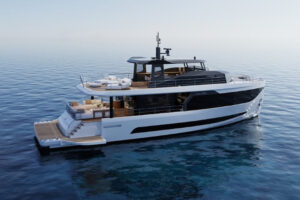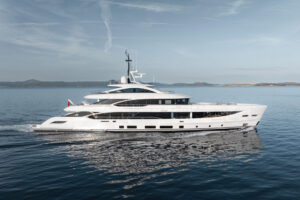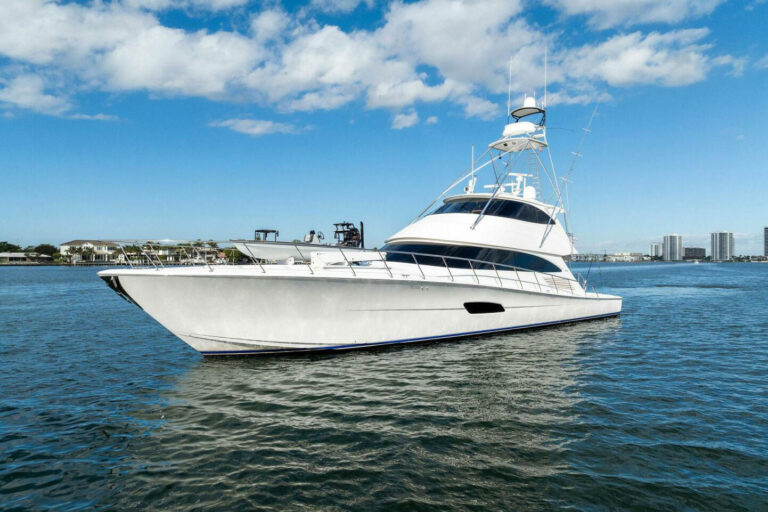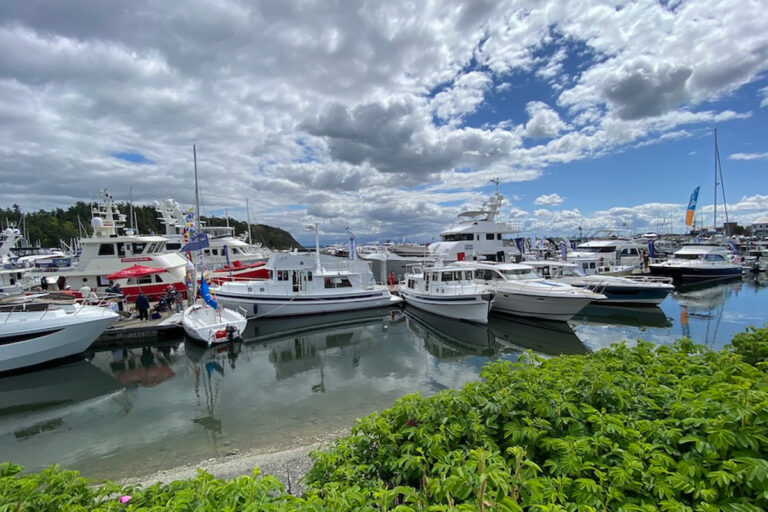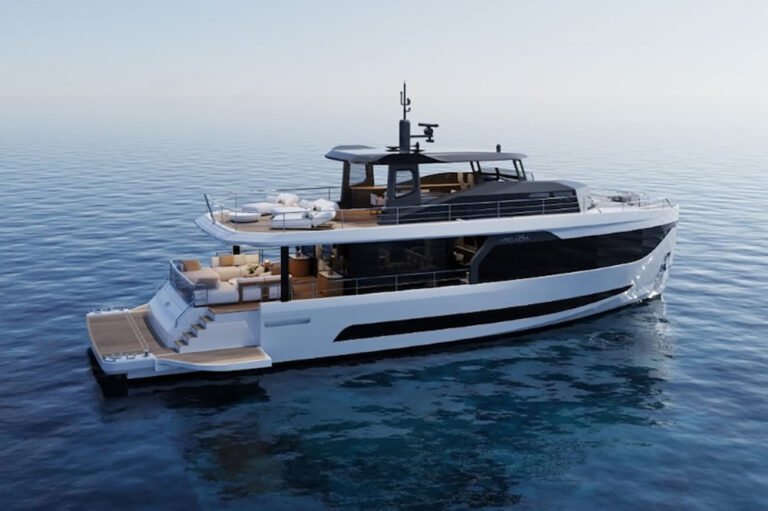We were 20 minutes out of the Golden Gate when the harmonic convergence hit: A pod of 30 dolphins broke the surface on our starboard side, and all three cellphones on board went off. Though we had only just said good-bye to our chase boat, our skipper throttled back the twin Mercury Verado 275 hp outboards so everyone could have a nice chat. “What’s this I hear?” asked my wife, Mindy, from New York City. “Are you really going to surf The Ranch?”
“There’s a chance-I mean, we just had a humongous front pass, but there’s a chance”-
“I’m making reservations. Bye!” To say I was amazed was no understatement: Mindy has avoided motorboats ever since an octopus-fishing expedition in Greece went rancid. But I had underestimated the power of the new Protector, whose motto, “Any Water Anywhere,” could now be amended with “And Your Surf-Crazed Hawaiian Wife, Too.”
The trip had started out as a simple case of finding a sufficiently grueling test for the Hauraki 40. No milk runs need apply for a vessel developed for the New Zealand Coast Guard by Rayglass Boats to handle the atrocious conditions of the rockbound Hauraki Coast. The result was a type of RIB that could charge waves-and, if necessary, reefs-like a rhino.
The early Rayglass designs were also used as tenders during the Kiwi America’s Cup Defenses, where San Franciscan Howard Shiebler spotted them and decided they had the right Humvee cachet for the Bay Area. With vice president Ralph Silverman and the dynamic assistance of his wife and marketing director, Tiffany Pelletier-Shiebler, the former financial services executive shepherded the development and importation of an American model, the Protector 28 (see “Maine Event,” November 2004), which has already found over a hundred buyers-in use as tenders, picnic boats, commuters, fishboats. “Ninety percent of our owners have a story,” said Tiffany, when I asked her to tell me about an interesting owner or two. “They lead fascinating lives.”
It’s easier to seem fascinating with a Protector. As we cruised past Ocean Beach and its gnarly double-overhead rollers, Ralph gave the helm of our well-appointed $430,000 starship to Dr. Bill Hancock, who owns a 28 and was thinking of buying a Hauraki 40 to commute to his two clinics, one in Seattle, the other in the San Juans, avoiding the tangle of local roads, bridges and ferries. Another customer owns an island in the Sacramento Delta and uses a Protector to bring customers in from San Francisco. Cellphones kept going off, people getting back to Ralph, including the wife of a Silicon Valley billionaire who already owned a 28. It sounded like we would be running a relay race of successful people with one thing in common: a yen to really get out and use their boats in different and challenging ways.
Which was the plan for this trip. We’d chosen our run for its rarity, ruggedness and beauty. Remote North Central California is hardly a boater’s paradise, and the stretch we were embarked on, San Francisco to Santa Barbara, is notorious for bad weather and thrashing seas. In addition, the coast is rocky and inhospitable, with only a few put-ins over its 210 miles. Finally, we were playing with a weather window, sandwiched between the heels of a front that had just dumped the earliest-ever snowfall in the Sierra Nevada and a following front that would unload another four feet of powder. Buoys were reading 15-foot swells the night before we departed.
Which was why the surfers were calling, of course. They were monitoring the swells, too, from weather faxes and on-line sites like Surfline.com. Two of Ralph’s friends in Santa Cruz. My wife. Then my sister in Long Beach. Then my brother. Then my sister’s daughter. All had the same idea-when we arrived in Santa Barbara on the backs of our storm front, it would have groomed itself into perfect waves at the world’s most famous, private, boat-accessible surf spot: the Hollister Ranch.
I felt like the first teenager in my gang to get a driver’s license. The Ranch was a two-day runaway, though. First came the steep downhill from San Francisco to Santa Cruz. It’s normally a knee-pounding trampoline experience, but gliding under the Golden Gate we entered a bubble of sunny calm punctuated by the heads of curious seals. An hour later we were veering in off Half Moon Bay so I could point out Maverick’s, the notorious big wave point that took the life of Hawaiian legend Mark Foo. Though the ocean was as glassy as a Fourth of July in Vinalhaven, I could see the backs of breakers throwing up veils of mist.
The sea stirred up at Ano Nuevo, home of a raucous herd of elephant seals (also known as the McDonald’s Two-Tonner to the area’s great white sharks). Harbor seals, otters and big elephants lolled on the surface as we slalomed lumpy seas; suddenly a big-snouted creature was bullying through our wake three waves back, exactly where sharks like to sit, according to Ralph. To propitiate the gods, I threw it a heel of bread.
Rounding the point of Monterey Bay, we passed another famous big wave spot, Steamer’s Lane, which was going off in clean sets. Then we ran in with a small fleet of sailboats from the UC Santa Cruz Sailing team, followed by a pair of Etchells dueling at a starting buoy under the eyes of a coach-on board a Protector 28, of course. One of our ride-alongs, Jim Granger, had the pleasure of casually hailing his daughter Jenna, a Santa Cruz student, on board her Slugfish: “Hi, honey!” She turned her head, did a double take. “What’s that boat, Dad-it’s awesome!” Not every dad makes such a cool entrance.
In Santa Cruz we bid farewell to the good doctor and, at 7 a.m. the next morning, took on our next two crew members, friends of Ralph’s, both lugging surfboards. Morgan Larson is a professional sailor, two-time America’s Cup veteran and current 505 World Champion. His friend Christa Scheer is a junior at the California Maritime Academy and will be a commercial second mate when she graduates. The boards each took an aft cabin berth, like brightly colored fiberglass crash-test dummies.
Morgan has raced sailboats down the coast many times and Christa has served as third mate on container ships to the Far East and Alaska. Both enjoyed setting our course on the chart plotter, using local highlights: the 18th green at Pebble Beach, glorious in fog and shafts of morning sun, the iconic lone cypress on the point of Point Lobos, then the sheer cliffs of Big Sur, as spectacular and remote a seacoast as can be found. Here Ralph stuck his head out of one of the two retractable sunroofs and quoted by memory the poet Robinson Jeffers, who immortalized the region and whose Tor House, built of beach boulders by his own hands, has probably never had a more salty homage.
Now we were entering the lonely coast, once home of condors and eagles and grizzlies, that had drawn Jeffers-and sunk many a vessel that had ventured too close to shore. In the Hauraki 40 we could nose in as we pleased, however, skirting great kelp beds and running through a Japanese landscape painting of redwood heights, foggy valleys, black pinnacles and offshore stacks. Morgan took us in to a hidden cleft in the cliffs to catch a glimpse of a 1930s bootlegger’s cave, still rigged out with a winch on the cliffs. When we headed back offshore, though, we hit a mogul field of waves, caused by swells from three different directions. We’d been holding to a steady 36 knots; now, teeth rattling in our heads, we dialed back to 30, then 25, then 24 where it was tolerable, barely.
Fortunately, this “potato patch” only lasted a bone-shaking hour, but it was enough to vibrate loose the gas caps on the twin tanks, something we discovered when we caught a whiff of gasoline. Back to riding only one swell again, we jacked the throttles. Despite our steady 40 knots the ride was comfortable-provided the padded curved banquette had your back. Crista even managed to sleep in the forward queen berth, Jim on the banquette, while I alternated lounging with standing and holding onto the helm bench’s grab rail, basking in the sunshine pouring through the sunroof and waving to the hundreds of seals and otters. The seals are so unused to boats here they pop up like prairie dogs to check you out; the otters lie on their backs cracking open mussels with a rock balanced on their bellies-something you almost have to see to believe.
Fifty miles south of Santa Cruz, Morro Bay’s dramatic rock hove into view. A Half Dome-like egg of granite attached to a sandspit, it guards a miles-long dogleg estuary and a time-warp working fishing port. The old guard certainly appreciated the Protector, hailing us as we idled up to the dock and adjacent Fish Market, where we filled up on gas and fried halibut. Then it was on to Santa Barbara, pushing around Point Concepcion, California’s Cape Horn, according to Richard Henry Dana in Two Years Before the Mast.
The day was fading but sunny and utterly beautiful when we came to the Hollister Ranch’s surf-swept bluffs, golden with green hills behind, kelp beds in front to strain and groom the onrushing swells. It looked great to me, but Morgan, our surf pilot, shook his head. The swell direction was wrong, and tomorrow’s report predicted the same or worse. As we proceeded to race the sunset into Santa Barbara, I wondered what I would tell my wife, sister, niece and nephew, brother and his girlfriend, all of whom had flown or driven long distances to join us tomorrow.
At dinner that night Morgan sprang the bad news, followed by a Plan B that was truly audacious: We’d head offshore at dawn, circle behind the Channel Islands 25 miles out, and island-hop along using our charts and Morgan’s eye try to pick off any point or beach breaks. These are uninhabited and rarely visited islands, and their backsides are known mostly to abalone and sea urchin divers, one or two of whom are taken in turn by great white sharks every year. This was much more adventurous than hitting The Ranch. This was like going into the Vietcong-occupied village in Apocalypse Now and surfing “Charlie’s Point.”
Bright and early we loaded the Protector: nine people, six surfboards and sacks of breakfast burritos and bottled water. Even fully laden the Hauraki boosted easily up on plane and made a steady 34 knots into a heavy beat of swell and black clouds rent by bolts of lightning-we’d overtaken the front that we’d chased all the way down. The prospects couldn’t be more dismaying, really, but we were laughing and shrieking in the drumming rain.
Ralph and Morgan took the Hauraki through the slot between Anacapa Island and bigger, dramatically eroded Santa Cruz Island; we crowded the rails to watch dolphin and study beaches from our on-board perspective. The jagged points were sloppy; the first beaches offered closed-out shore-break. An hour passed, profitably spent in watching a beautiful and strange landscape, with diminishing hopes for surf.
Then we rounded a point where a Lost World valley came down to a bluff-side beach. It was lonely, kelp-shielded-“sharky,” my wife said-and the waves were breaking. Threading through the kelp labyrinth, Ralph brought us within 300 yards and used the thrusters to present the dive platform for anyone fool enough to use it. The rain was pelting. You could feel the brave mood flickering out.
And then here came my niece out of the aft berth, totally encased in rubber from head to toe. Having just filmed and released her own surf movie about her travels in New Zealand and Australia, Surfabout, Jenny Hedley wasn’t going to let a little rain stop her. Flinging herself in, she paddled, caught a wave, ran up and down the beach-and gave us the high sign. In we went, wife, nephew, brother and his girlfriend, Morgan and Christa and me. And there, under a pale yellow cliff in a place so remote from Southern California it could have been Patagonia, we had hours of waves direct from the Gulf of Alaska, all to ourselves.
We also had a hot aft-cockpit shower when we got out of the 60-degree water. “Just another seamless Protector day,” said Ralph as we headed back to Santa Barbara, making the 30-mile run in under an hour, and his cellphone started to ring.
Contact: Protector Boats, (510) 749-9300; www.ProtectorBoats.com.


